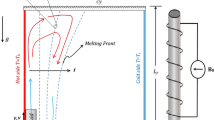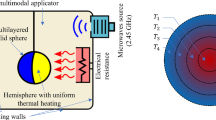Abstract
Since the effect of microwave heating is closely related to the electromagnetic parameters of the material, the heated material often exhibits selective heating. This article uses a multi-mode microwave resonant cavity to heat sodium chloride. The finite difference time domain (FDTD) method was used to simulate the electromagnetic field and thermal field equation in the microwave heating process. The heating rate of microwave heating sodium chloride was changed in real time with the change of the electromagnetic characteristic parameters. The analysis results show that with the increase of the relative permittivity of sodium chloride, the electric field intensity of sodium chloride in the cavity increases, the heating rate increases, and the distribution of the electromagnetic field becomes more uniform.
Access provided by Autonomous University of Puebla. Download conference paper PDF
Similar content being viewed by others

Keywords
1 Introduction
Compared with traditional heating, microwave heating as a clean and efficient green energy has been widely used in many fields [1,2,3,4]. The effective heating object of microwave drying is mainly the small amount of water to be dried. Because the effect of microwave heating is closely related to the electromagnetic characteristic parameters of the material, it is very important to study the electromagnetic properties of the material during microwave heating with the change of temperature. Li Pengfei and Xie Gaijun used the FDTD method to establish the electromagnetic-thermal coupling model of ceramic microwave heating [5]. Zhu J et al. analyzed the effect of dielectric properties on the temperature distribution by studying continuous fluid microwave heating [6]. Torres F and Jecko B et al. studied the relationship between the dielectric parameters and the temperature rise of heated objects. The effects of dielectric parameters on microwave heating have been obtained [7].
In order to study the relationship between electromagnetic properties and dielectric parameters of sodium chloride in microwave drying process. In this paper, the time domain finite difference method is used to simulate the heating rate of sodium chloride in the resonant cavity with the electromagnetic characteristic parameters. The relationship between the dielectric parameters of sodium chloride and the heating rate and electric field distribution at different temperatures was obtained.
2 Electromagnetic-Thermal Coupling
In the electromagnetic coupling process, it is divided into two parts: electromagnetic calculation and heat transfer. The FDTD algorithm takes the Yee grid as the discrete element of the electromagnetic field and converts the Maxwell curl equations into differential equations so that the electromagnetic fields are alternately distributed in time and space.
where \( \overrightarrow {H} \) is the electric field strength; \( \overrightarrow {D} \) is the electric displacement; \( \overrightarrow {E} \) is the magnetic field strength; \( \overrightarrow {B} \) is the magnetic flux density; \( \overrightarrow {J} \) is the current density; \( \overrightarrow {M} \) is the magnetic current density.
The medium in the cavity absorbs the electromagnetic wave in the heating process and converts the absorbed electromagnetic wave into a heat source, that is
where σ is the effective conductivity of the entire material system \( (\sigma = \omega \varepsilon^{{\prime \prime }} \tan \delta ) \) and the imaginary part of the complex permittivity of the material. E is the electric field strength in the cavity. ε0 is the dielectric constant of the material without external electric field. \( \varepsilon^{{\prime }} \) is the relative permittivity. f is the microwave frequency. tan δ is the dielectric loss tangent. Reflects the ability of the medium to absorb microwave energy [8].
At time t, the temperature change at the interior point (x, y, z) of the medium satisfies the heat conduction equation;
where ρ is the dielectric density. Cm is the specific heat capacity. kt is the thermal conductivity. P is the heat flux, which is equivalent to the heat source at that point. Using FDTD grid form of discrete, for ∆x = ∆y = ∆z = ∆, Material absorption of microwave energy into heat energy after the heating rate;
Among them T, ρ, cp and t are the material temperature, density, constant pressure mass specific heat capacity and heating time.
The main research of microwave electromagnetic-thermal model is that the electromagnetic calculation and the thermal process should be organically combined by an appropriate method so that the actual object can be accurately simulated. The microwaves act on the object being heated and generate microwave losses, therein the energy of the microwave losses being converted into heat. The heat of conversion in the thermal model in the form of heat transfer in the object, the temperature distribution of the object changes, the temperature changes will lead to the object of the dielectric constant and other relevant parameters change, so that the entire electromagnetic field distribution also followed by recalculation, changes in electromagnetic field values make the microwave loss also make the corresponding changes, so repeatedly until the end of the simulation.
3 Numerical Results and Discussion
During the heating process, the medium absorbs electromagnetic waves and converts the absorbed electromagnetic waves into heat sources. The ability of medium to absorb microwave depends mainly on dielectric parameters. Therefore, in this paper, the electromagnetic sensitivity of dielectric parameters is studied. The model of the study is shown in the following figure. The model consists of a resonant cavity and a transmission waveguide (Fig. 1).
The length, width and height of the resonator in the model are 200 mm, 100 mm and 100 mm, respectively. Transmission waveguide length, width and height dimensions were 43, 140 and 22 mm. In this paper, the source of excitation is the differential Gaussian pulse source, and the uniaxial perfectly matched layer (UPML) is its boundary condition with the center frequency of 2.45 GHz. In the calculation of modeling and calculation of convenience, the use of equal-interval discrete. Microwave heating process, the material warmed, will change the internal structure of the heated material, resulting in the dielectric properties of the material being heated changes. This will in turn affect the absorption efficiency of microwaves by the material being heated. Therefore, the influence of the dielectric properties of the material to be heated on the microwave heating effect needs to be considered.
3.1 The Influence of Temperature on the Electric Field Distribution of Sodium Chloride
Considering the influence of different dielectric parameters on the electromagnetic field distribution of sodium chloride during microwave drying. According to Table 1, the dielectric parameter, dielectric loss and loss tangent values at 4% sodium chloride are listed, and the variation of the electromagnetic field of the sodium chloride at the working frequency of 2.45 GHz in the cavity.
Figure 2 shows when the excitation source is fed from the x-o-z plane, at a time step of 3000. The MATLAB software is used to calculate the distribution of the electric field in the cavity of the cavity at the temperature of 20 °C, 60 °C and 80 °C, respectively, under the condition of the boundary condition and the excitation source of the cavity are not changed. With the temperature of sodium chloride increases, the dielectric parameter also increases. From Fig. 2 can be seen, when the sodium chloride in the cavity is 20 °C, its electric field distribution shows a clear standing wave state. When 60 °C sodium chloride is added into the cavity, the electric field distribution change significantly and is more uniform. When the cavity is filled with sodium chloride with a higher relative permittivity, the temperature is 80 °C, and the distribution of the electric field is more uniform than that of the sodium chloride at 60 °C. Therefore, it can be seen that when the cavity is filled with sodium chloride at different temperatures, and the electric field distribution in the cavity is more uniform with the increase of the dielectric parameter of sodium chloride.
3.2 Electromagnetic Susceptibility Analysis of Dielectric Parameter for Sodium Chloride Heating Rate
At the same time, the relationship between heating rate and heating time of sodium chloride with different dielectric parameters in the cavity was calculated. The dielectric parameter was 4.55, 5.0 and 5.48, respectively. As shown in Fig. 3, as the heating time increases, the heating rate of sodium chloride continues to increase. When the running time is 400 times steps, the heating rate of sodium chloride changes rapidly, and the heating rate tends to be gentle with the heating time. This is mainly due to the weakening of the electromagnetic field inside the cavity and the change of the thermophysical parameters. The weakening of the electromagnetic field may be due to the change in the permeability of the material in the cavity, so that most of the microwaves emitted by the microwave source are reflected back into the microwave source, thus, reducing the electromagnetic field strength inside the cavity. However, the final temperature increase of sodium chloride will tend to balance and remain unchanged. It shows that with the change of the dielectric parameter of the medium in the cavity, the heating rate in the cavity will also change.
4 Conclusion
Based on the FDTD method to establish thermal coupling model electromagnetic Maxwell equations and the heat conduction equation. This article simulates a different dielectric parameter heating rate in sodium chloride. The heating rate curve of sodium chloride was obtained. Raising the temperature of sodium chloride can significantly improve the absorption characteristics of sodium chloride, and then converting electromagnetic energy into heat energy to promote faster temperature rise of sodium chloride and rapid heating and drying.
References
Wenxiang W (2009) Microwave engineering technology. National Defence Industry Press, Beijing, pp 1–5
Jie L, Bangwen Z, Baowei L (2010) Experimental study on process of microwave magnetizing roast plus magnetic separation for medium-low grade oxidized ores containing hematite of Bayan obo. Metal Mine 407(5):89–91
Ying T (2007) Numerical modeling study of microwave heating CaO-SiO2 system materials. Wuhan University of Technology, Wuhan
Xiaoqing Y, Kama H (2006) Investigation of key problems of interaction betweenmicrowave and chemical reaction. J Radio Sci 21(5):802–809
Pengfei LI (2010) Study of microwave heating model based on ADI-FDTD. University of Electronic Science and technology of China, Chengdu
Zhu J, Kuznetsov AV, Sandeep KP (2007) Mathematical modeling of continuous flow microwave heating of liquids (effects of dielectric properties and design parameters). Int J Therm Sci 46(4):328–341
Torres F, Jecko B (1997) Complete FDTD analysis of microwave heating processes in frequency-dependent and temperature-dependent media. IEEE Trans Microwave Theor Tech 45(1):108
Kama H et al (1996) New characteristics of oxido-reduction reaction of KI and KMn04 irradiated by amplitude-modulated electromagnetic waves. Chin Sci Bull 41(15):1259–1262
Chenhui L (2014) Study on new technology of microwave heating based on dielectric properties of metallurgical materials. Kunming University of Science and Technology, Kunming
Acknowledgements
This research is funded by the National Natural Science Foundation (Project No. 51304097), Yunnan Provincial Fund Project (Project No. 2013FZ016), Key Project of Yunnan Provincial Department of Education (Project No. 2015Z026), Yunnan Provincial Key Program of Applied Basic Research Projects (Project No. 2015FA017).
Author information
Authors and Affiliations
Corresponding author
Editor information
Editors and Affiliations
Rights and permissions
Copyright information
© 2021 Springer Nature Singapore Pte Ltd.
About this paper
Cite this paper
Chen, J., Wang, W., Lin, H., Chen, H. (2021). Influence of Electromagnetic Characteristics of Sodium Chloride on Temperature Change During Microwave Drying. In: Xu, L., Zhou, L. (eds) Proceedings of the 8th International Multidisciplinary Conference on Optofluidics (IMCO 2018). IMCO 2018. Lecture Notes in Electrical Engineering, vol 531. Springer, Singapore. https://doi.org/10.1007/978-981-13-3381-1_8
Download citation
DOI: https://doi.org/10.1007/978-981-13-3381-1_8
Published:
Publisher Name: Springer, Singapore
Print ISBN: 978-981-13-3380-4
Online ISBN: 978-981-13-3381-1
eBook Packages: EngineeringEngineering (R0)






